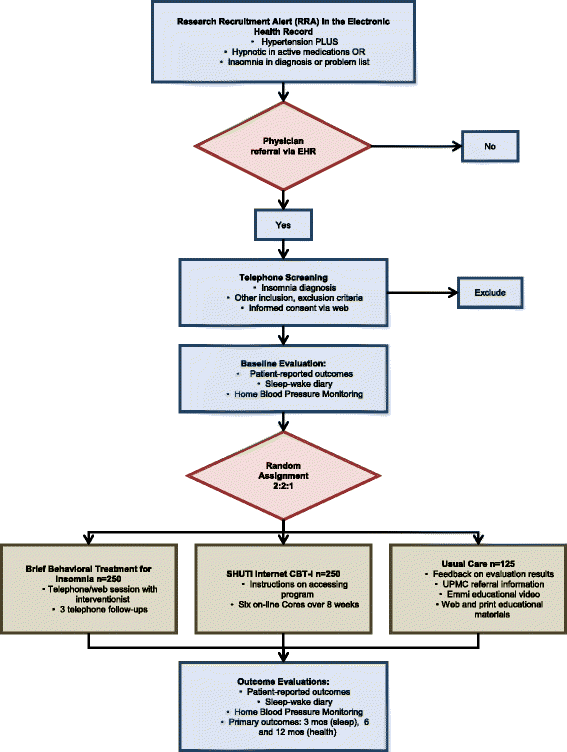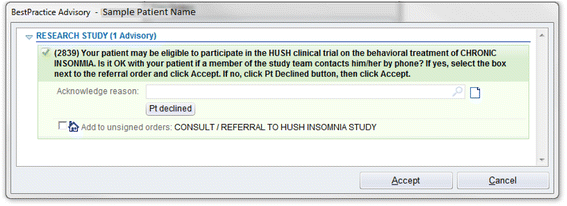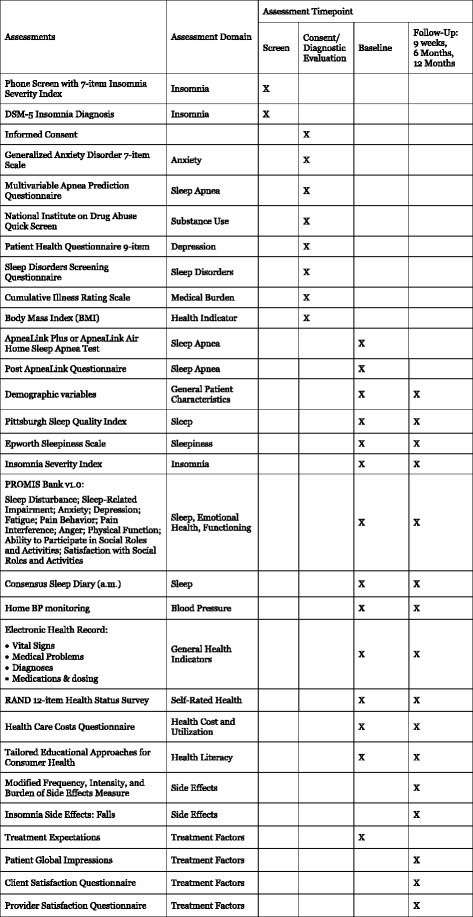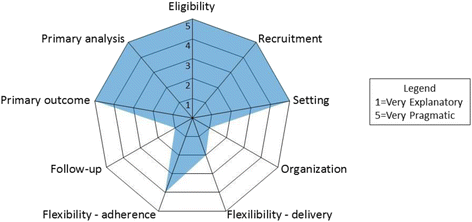Hypertension with unsatisfactory sleep health (HUSH): study protocol for a randomized controlled trial
- PMID: 28587609
- PMCID: PMC5461741
- DOI: 10.1186/s13063-017-2001-9
Hypertension with unsatisfactory sleep health (HUSH): study protocol for a randomized controlled trial
Abstract
Background: Insomnia is common in primary care medical practices. Although behavioral treatments for insomnia are safe, efficacious, and recommended in practice guidelines, they are not widely-available, and their effects on comorbid medical conditions remain uncertain. We are conducting a pragmatic clinical trial to test the efficacy of two cognitive behavioral treatments for insomnia (Brief Behavioral Treatment for Insomnia (BBTI) and Sleep Healthy Using the Internet (SHUTi)) versus an enhanced usual care condition (EUC).
Methods/design: The study is a three-arm, parallel group, randomized controlled trial. Participants include 625 adults with hypertension and insomnia, recruited via electronic health records from primary care practices affiliated with a large academic medical center. After screening and baseline assessments, participants are randomized to treatment. BBTI is delivered individually with a live therapist via web-interface/telehealth sessions, while SHUTi is a self-guided, automated, interactive, web-based form of cognitive behavioral therapy for insomnia. Participants in EUC receive an individualized sleep report, educational resources, and an online educational video. Treatment outcomes are measured at 9 weeks, 6 months, and 12 months. The primary outcome is patient-reported sleep disturbances. Secondary outcomes include other self-reported sleep measures, home blood pressure, body mass index, quality of life, health functioning, healthcare utilization, and side effects.
Discussion: This randomized clinical trial compares two efficacious insomnia interventions to EUC, and provides a cost-effective and efficient examination of their similarities and differences. The pragmatic orientation of this trial may impact sleep treatment delivery in real world clinical settings and advance the dissemination and implementation of behavioral sleep interventions.
Trial registration: ClinicalTrials.gov (Identifier: NCT02508129 ; Date Registered: July 21, 2015).
Keywords: Blood pressure; Hypertension; Sleep; Technology.
Figures
Similar articles
-
Effect of a Web-Based Cognitive Behavior Therapy for Insomnia Intervention With 1-Year Follow-up: A Randomized Clinical Trial.JAMA Psychiatry. 2017 Jan 1;74(1):68-75. doi: 10.1001/jamapsychiatry.2016.3249. JAMA Psychiatry. 2017. PMID: 27902836 Clinical Trial.
-
Solving insomnia electronically: Sleep treatment for asthma (SIESTA): A study protocol for a randomized controlled trial.Contemp Clin Trials. 2019 Apr;79:73-79. doi: 10.1016/j.cct.2019.02.011. Epub 2019 Feb 27. Contemp Clin Trials. 2019. PMID: 30825525 Free PMC article.
-
Nurse-delivered sleep restriction therapy to improve insomnia disorder in primary care: the HABIT RCT.Health Technol Assess. 2024 Aug;28(36):1-107. doi: 10.3310/RJYT4275. Health Technol Assess. 2024. PMID: 39185919 Free PMC article. Clinical Trial.
-
Brief Behavioral Treatment of Insomnia.Sleep Med Clin. 2019 Jun;14(2):235-243. doi: 10.1016/j.jsmc.2019.02.003. Epub 2019 Apr 1. Sleep Med Clin. 2019. PMID: 31029189 Review.
-
Enhancing sleep quality for adult patients: Interventions and insights.Nurse Pract. 2024 Jul 1;49(7):22-30. doi: 10.1097/01.NPR.0000000000000199. Epub 2024 Jun 25. Nurse Pract. 2024. PMID: 39149863 Review.
Cited by
-
Facing the Realities of Pragmatic Design Choices in Environmental Health Studies: Experiences from the Household Air Pollution Intervention Network Trial.Int J Environ Res Public Health. 2022 Mar 23;19(7):3790. doi: 10.3390/ijerph19073790. Int J Environ Res Public Health. 2022. PMID: 35409475 Free PMC article. Clinical Trial.
-
Minimal effect of sleep on the risk of age-related macular degeneration: a Mendelian randomization study.Front Aging Neurosci. 2023 Aug 21;15:1159711. doi: 10.3389/fnagi.2023.1159711. eCollection 2023. Front Aging Neurosci. 2023. PMID: 37671084 Free PMC article.
-
Association between blood pressure and parameters related to sleep disorders in Tabari cohort population.Clin Hypertens. 2022 Nov 15;28(1):33. doi: 10.1186/s40885-022-00216-3. Clin Hypertens. 2022. PMID: 36376986 Free PMC article.
-
Effects of Sihogayonggolmoryeo-tang (Saikokaryukotsuboreito or Chai-Hu-Jia-Long-Gu-Mu-Li-Tang) for insomnia disorder with prehypertension or stage 1 hypertension: A study protocol for a randomized controlled trial.Medicine (Baltimore). 2020 Jul 17;99(29):e20980. doi: 10.1097/MD.0000000000020980. Medicine (Baltimore). 2020. PMID: 32702837 Free PMC article.
-
Is this study feasible? Facilitating management of pragmatic trial planning milestones under a phased award funding mechanism.Trials. 2019 May 30;20(1):307. doi: 10.1186/s13063-019-3387-3. Trials. 2019. PMID: 31146778 Free PMC article.
References
MeSH terms
Associated data
Grants and funding
LinkOut - more resources
Full Text Sources
Other Literature Sources
Medical





